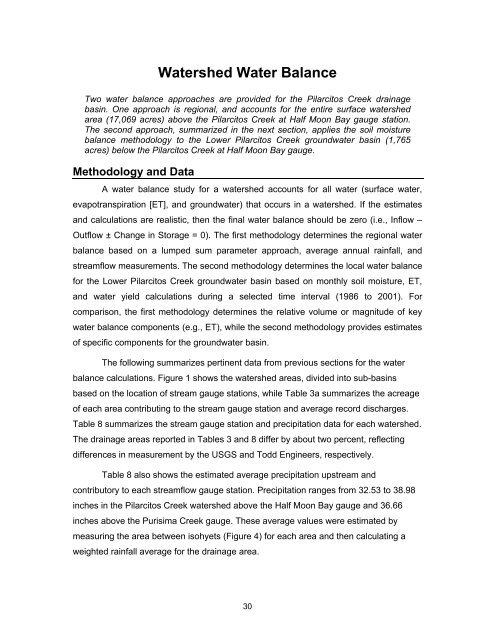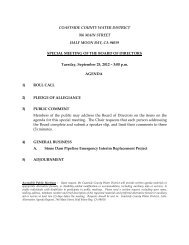Lower Pilarcitos Creek Groundwater Basin Study - Coastside ...
Lower Pilarcitos Creek Groundwater Basin Study - Coastside ...
Lower Pilarcitos Creek Groundwater Basin Study - Coastside ...
Create successful ePaper yourself
Turn your PDF publications into a flip-book with our unique Google optimized e-Paper software.
Watershed Water Balance<br />
Two water balance approaches are provided for the <strong>Pilarcitos</strong> <strong>Creek</strong> drainage<br />
basin. One approach is regional, and accounts for the entire surface watershed<br />
area (17,069 acres) above the <strong>Pilarcitos</strong> <strong>Creek</strong> at Half Moon Bay gauge station.<br />
The second approach, summarized in the next section, applies the soil moisture<br />
balance methodology to the <strong>Lower</strong> <strong>Pilarcitos</strong> <strong>Creek</strong> groundwater basin (1,765<br />
acres) below the <strong>Pilarcitos</strong> <strong>Creek</strong> at Half Moon Bay gauge.<br />
Methodology and Data<br />
A water balance study for a watershed accounts for all water (surface water,<br />
evapotranspiration [ET], and groundwater) that occurs in a watershed. If the estimates<br />
and calculations are realistic, then the final water balance should be zero (i.e., Inflow –<br />
Outflow ± Change in Storage = 0). The first methodology determines the regional water<br />
balance based on a lumped sum parameter approach, average annual rainfall, and<br />
streamflow measurements. The second methodology determines the local water balance<br />
for the <strong>Lower</strong> <strong>Pilarcitos</strong> <strong>Creek</strong> groundwater basin based on monthly soil moisture, ET,<br />
and water yield calculations during a selected time interval (1986 to 2001). For<br />
comparison, the first methodology determines the relative volume or magnitude of key<br />
water balance components (e.g., ET), while the second methodology provides estimates<br />
of specific components for the groundwater basin.<br />
The following summarizes pertinent data from previous sections for the water<br />
balance calculations. Figure 1 shows the watershed areas, divided into sub-basins<br />
based on the location of stream gauge stations, while Table 3a summarizes the acreage<br />
of each area contributing to the stream gauge station and average record discharges.<br />
Table 8 summarizes the stream gauge station and precipitation data for each watershed.<br />
The drainage areas reported in Tables 3 and 8 differ by about two percent, reflecting<br />
differences in measurement by the USGS and Todd Engineers, respectively.<br />
Table 8 also shows the estimated average precipitation upstream and<br />
contributory to each streamflow gauge station. Precipitation ranges from 32.53 to 38.98<br />
inches in the <strong>Pilarcitos</strong> <strong>Creek</strong> watershed above the Half Moon Bay gauge and 36.66<br />
inches above the Purisima <strong>Creek</strong> gauge. These average values were estimated by<br />
measuring the area between isohyets (Figure 4) for each area and then calculating a<br />
weighted rainfall average for the drainage area.<br />
30



